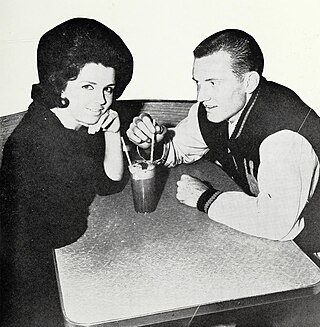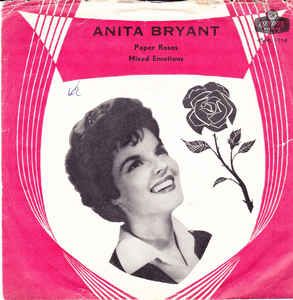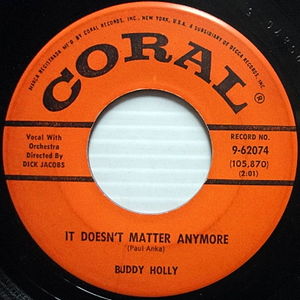Related Research Articles
Ernest William Sigley was an Australian Gold Logie award winning television host, comedian, variety performer, radio presenter and singer. Known as a pioneer of radio and television in Australian, he was often styled as a "little Aussie battler" with a larrikin sense of humour.
"You Always Hurt the One You Love" is a pop standard with lyrics by Allan Roberts and music by Doris Fisher. First recorded by the Mills Brothers, whose recording reached the top of the Billboard charts in 1944, it was also a hit for Sammy Kaye in 1945.

Denise Anne Christina Drysdale is an Australian television presenter, variety entertainer, actress, singer, dancer and comedian. She is often affectionately known as 'Ding Dong', a nickname invented by fellow performer Ernie Sigley. She was formerly a co-host of the morning show Studio 10.

Paul & Paula, consisting of Raymond Glenn "Ray" Hildebrand and Jill Jackson, were an American pop singing duo, best known for their 1962 million-selling, number-one hit record, "Hey Paula".
"Magic Moments" is a popular song composed by Burt Bacharach and written by Hal David, being one of the first songwriting collaborations by that duo. This song was recorded by Perry Como and released in 1957 as the B-side of his "Catch a Falling Star"; it reached No. 1 in the UK in 1958.

"I Can't Stop Loving You" is a popular song written and composed by country singer, songwriter, and musician Don Gibson, who first recorded it on December 3, 1957, for RCA Victor Records. It was released in 1958 as the B-side of "Oh, Lonesome Me", becoming a double-sided country hit single. At the time of Gibson's death in 2003, the song had been recorded by more than 700 artists, most notably by Ray Charles, whose recording reached No. 1 on the Billboard chart.
"Deep Purple" is a song and the biggest hit written by pianist Peter DeRose, who broadcast between 1923 and 1939 with May Singhi as "The Sweethearts of the Air" on the NBC radio network. The British rock band Deep Purple named themselves after the song.

"Who's Sorry Now?" is a popular song with music written by Ted Snyder and lyrics by Bert Kalmar and Harry Ruby. It was published in 1923 as a waltz. Isham Jones had a hit recording in 1923 with the song arranged as a foxtrot. Later sheet music arrangements, such as the 1946 publication that was a tie-in to the film A Night in Casablanca, were published in 2
2 time. Other popular versions in 1923 were by Marion Harris, Original Memphis Five, Lewis James, and Irving Kaufman.
"Come Softly to Me" is a popular song recorded by The Fleetwoods, composed of Gretchen Christopher, Barbara Ellis, and Gary Troxel, who also wrote it. The original title was "Come Softly", but was changed en route to its becoming a hit. Bob Reisdorf, the owner of Dolphin Records, which in 1960 changed to Dolton Records, was responsible for the title change. He thought that "Come Softly" might be too obvious and considered risqué, so he had it changed to "Come Softly to Me." The title phrase never appears in the song's lyrics.

"Breaking Up Is Hard to Do" is a song recorded by Neil Sedaka, co-written by Sedaka and Howard Greenfield. Sedaka recorded this song twice, in 1962 and 1975, in two significantly different arrangements, and it is considered to be his signature song. Between 1970 and 1975, it was a top-40 hit three separate times for three separate artists: Lenny Welch, The Partridge Family and Sedaka's second version.
"It's All in the Game" is a pop song whose most successful version was recorded by Tommy Edwards in 1958. Carl Sigman composed the lyrics in 1951 to a wordless 1911 composition titled "Melody in A Major", written by Charles G. Dawes, who was later Vice President of the United States under Calvin Coolidge. It is the only No. 1 single in the U.S. to have been co-written by a U.S. Vice President or a Nobel Peace Prize laureate.

"Sherry" is a song written by Bob Gaudio and recorded by The Four Seasons.
"Together Again" is a 1964 song by American country singer and guitarist Buck Owens.

"Paper Roses" is a popular song written and composed by Fred Spielman and Janice Torre. It first was a top five hit in 1960 for Anita Bryant. Marie Osmond recorded it in 1973 and took her version to number one on the US country chart.
"Catch a Falling Star" is a song written by Paul Vance and Lee Pockriss. It was made famous by Perry Como who recorded and released his version in late 1957.

"Easier Said Than Done" is a popular song sung by The Essex that was a number-one song in the United States during 1963. It topped the Billboard Hot 100 singles chart on July 6, 1963, and remained there for two weeks. The song was written by William Linton and Larry Huff.

"I'm Leaving It Up to You" is a song written by and originally performed by Don Harris and Dewey Terry in 1957. It was later popularized in 1963 by the American duo Dale and Grace, who took it to #1 on the Billboard Hot 100 chart. In 1974, Donny and Marie Osmond reached the top five on the US Hot 100 chart and peaked at #1 on the Billboard Hot Adult Contemporary chart with their cover.

"Hey Girl" is a song written and composed by Gerry Goffin and Carole King. It first became a popular Top ten hit on the Billboard Hot 100 in August 1963 when recorded by Freddie Scott. Donny Osmond took the song back to the Billboard top ten chart with his cover in 1971. Billy Joel recorded a version of the song for his 1997 album Greatest Hits Volume III.
"Young Lovers" is a song written by Ray Hildebrand and Jill Jackson, and performed under the name Paul & Paula. It was the follow-up to their number-one hit, "Hey Paula".

"It Doesn't Matter Anymore" is a pop ballad written by Paul Anka and recorded by Buddy Holly in 1958. The song was issued in January 1959, less than a month before Holly's death. "It Doesn't Matter Anymore" reached number 13 as a posthumous hit on the Billboard Hot 100 chart in early 1959, shortly after Holly was killed in a plane crash on February 3, 1959. The single was a two-sided hit, backed with "Raining in My Heart". "It Doesn't Matter Anymore" was Holly's last US Top 20 hit and featured the orchestral backing of Dick Jacobs. It was also successful in the United Kingdom, where it became the country's first posthumous number 1 hit.
References
- ↑ Breihan, Tom (May 9, 2018). "The Number Ones: Paul & Paula's "Hey Paula"". Stereogum . Retrieved June 10, 2023.
There was so much great pop music in the pre-Beatles era...yet a song like "Hey Paula" is pretty much what people imagine when they think about that stretch.
- ↑ Whitburn, Joel (2004). Top R&B/Hip-Hop Singles: 1942-2004. Record Research. p. 453.
- ↑ "CHUM Hit Parade - February 4, 1963".
- ↑ "Ray Hildebrand - Hey Paula Official Site". rayhildebrand.com. Retrieved 28 March 2019.
- 1 2 Shannon, Bob; John Javna (1986). Behind The Hits:Inside Stories of Classic Pop and Rock and Roll. New York: Warner Books. pp. 112–113. ISBN 0-446-38171-3.
- ↑ James, Gary. "Interview With Ray Hildebrand of Paul and Paula". Classicbands.com. Retrieved Nov 17, 2009.
- ↑ Joel Whitburn, Top Pop Singles 1955-1999 (Menomonee Falls, WI: Record Research, 2000), 491.
- ↑ "Hey Paula - Ernie Sigley & Denise Drysdale (1974)". www.poparchives.com.au. Retrieved 28 March 2019.
- ↑ "Cash Box Magazine" (PDF). Cash Box . October 19, 1974. p. 36. Retrieved November 15, 2021– via World Radio History.
- ↑ "National Top 100 Singles for 1974". Kent Music Report. 30 December 1974. Retrieved 15 January 2022– via Imgur.
- ↑ "American single certifications – Paul & Paula – Hey Paula". Recording Industry Association of America.